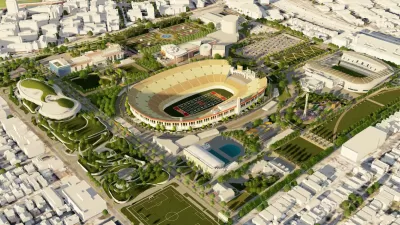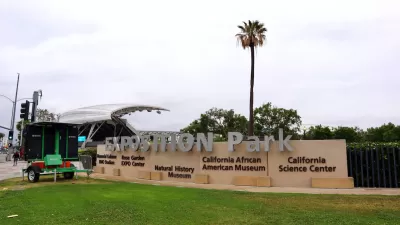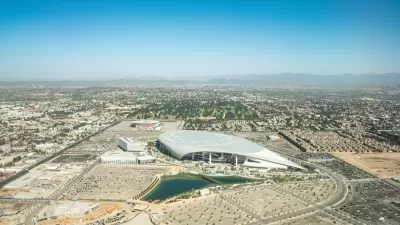Critics say the HUD program is meant to fund more direct anti-poverty measures, like affordable housing—not office, retail, and attractions.

Los Angeles city council recently voted to ask HUD for a loan of $22.5 million to fund commercial development around the MLS soccer stadium, slated to open in Exposition Park in 2018. Johnny Magdaleno explains in NextCity:
Through the Department of Housing and Urban Development’s Section 108 program, cities can qualify for low-interest loans to fill small funding gaps for development projects if these projects promise to give up to 51 percent of the jobs they create to low-income populations, and act as an economic boon for surrounding communities. The average loan amount is $4.9 million, and cities usually get between 10 and 20 years to pay them off.
Typically, the funds are awarded for community revitalization and anti-poverty projects. Even considering job creation, critics argue that construction of a sports museum, culinary academy, and conference center, among other things, would not be a faithful application of the program.
"When it comes to massive projects like a stadium, the long-term economic impacts on nearby communities are usually neutral or slightly negative," Magdaleno notes. And if anti-poverty funds get "eaten up" by a bad project, "it’s a double blow to the disadvantaged citizens these federal programs were crafted for."
He adds:
At the same time it’s giving out resources to commercial and industrial projects, HUD continues to slash funding for its affordable housing initiatives, and as of 2015 federal spending on housing assistance was $2.9 billion under what it was in 2004. That’s despite the fact that the number of families with access to rental assistance is at its lowest point in a decade, while demand is on the rise.
FULL STORY: L.A. Asks HUD to Back Private Sports Complex

Maui's Vacation Rental Debate Turns Ugly
Verbal attacks, misinformation campaigns and fistfights plague a high-stakes debate to convert thousands of vacation rentals into long-term housing.

Planetizen Federal Action Tracker
A weekly monitor of how Trump’s orders and actions are impacting planners and planning in America.

In Urban Planning, AI Prompting Could be the New Design Thinking
Creativity has long been key to great urban design. What if we see AI as our new creative partner?

Milwaukee Launches Vision Zero Plan
Seven years after the city signed its Complete Streets Policy, the city is doubling down on its efforts to eliminate traffic deaths.

Portland Raises Parking Fees to Pay for Street Maintenance
The city is struggling to bridge a massive budget gap at the Bureau of Transportation, which largely depleted its reserves during the Civd-19 pandemic.

Spokane Mayor Introduces Housing Reforms Package
Mayor Lisa Brown’s proposals include deferring or waiving some development fees to encourage more affordable housing development.
Urban Design for Planners 1: Software Tools
This six-course series explores essential urban design concepts using open source software and equips planners with the tools they need to participate fully in the urban design process.
Planning for Universal Design
Learn the tools for implementing Universal Design in planning regulations.
Gallatin County Department of Planning & Community Development
Heyer Gruel & Associates PA
JM Goldson LLC
City of Camden Redevelopment Agency
City of Astoria
Transportation Research & Education Center (TREC) at Portland State University
Jefferson Parish Government
Camden Redevelopment Agency
City of Claremont





























